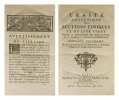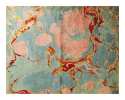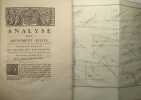8 books for « l hospital marquis de »Edit
-
Topics
Geometry (2)
Mathematics (2)
Sciences (2)
Tea (1)
-
Countries
Denmark (2)
France (5)
Switzerland (1)
-
Syndicate
ILAB (6)
NVVA (1)
SLACES (1)
SLAM (3)
Analyse des infiniment petits pour l'intelligence des lignes courbes
P., Montalant, 1716, un volume in 4 relié en plein veau, dos orné de fers dorés (reliure de l'époque), (un mors très légèrement fendu sur 2 cm, petite épidermure à un mors, plats légèrement frottés), 16pp., 182pp., 11 PLANCHES DEPLIANTES
---- BON EXEMPLAIRE ---- Seconde édition ---- "THE FIRST TEXTBOOK OF THE DIFFERENTIAL CALCULUS". (DSB) ---- "L'hospital was a major figure in the early development of the calculus on the continent... For several generations after his death, his fame was based on his book Analyse des infiniment petits pour l'intelligence des lignes courbes...". (DSB VIII pp. 304/305) ---- "G.F.A. L'Hospital (1661/1704), a pupil of Johann Bernoulli, has already been mentioned as taking part in the challenges issues by Leibniz and the Bernoullis. He helped powerfully in making the calculus of Leibniz better known to the mass of mathematicians by the publication of a treatise thereon, the Analyse des infiniment petits. This contains the method of finding the limiting value of a fraction whose two terms tend toward zero at the same time, due to Johann Bernoulli". (Cajori p. 224)**8080/ARB4
Traité analytique des sections coniques et de leur usage pour la résolution des équations dans les problèmes tant déterminez qu'indeterminez.
A Paris Chez Montalant. 1720 459p 1 volume In4. Reliure d'époque en plein velin. Dos lisse avec pièce de titre. Tranches marbrèes. Ouvrage postume. Deuxième édition (la première date de 1701). 33 planches dépliantes en fin de volume (la planche 25 qui manquait à été refaite à la main) et
"L'HÔSPITAL, (GUILLAUME FRANÇOIS ANTOINE) MARQUIS DE. - CARTESIAN GEOMETRY APPLIED TO THE CONIC SECTIONS.
Reference : 48217
(1707)
Traité Analytique des Sections Coniques et de leur Usage pour la Resolution des Equations dans les Problêmes tant déterminez qu'indéterminez. Ouvrage Posthume.
Paris, Jean Boudot et Jean Boudet fils, 1707. 4to. Contemporary full calf. A bit of cracking to front hinges, so that cords are seen, but cover not loosening. Spine with 6 raised bands, richly gilt compartments. Wear to top of spine. Two small old paperlabels, one to upper compartment, one to frontcover. Covers slightly rubbed. (4),459,(5) pp. Large woodcut vignette on titlepage, 2 other vignettes, one engraved , one in woodcut. 32 folded engraved plates and one smaller folded plate (Fig. A). An old owners stamp on flyleaf. Internally clean and fine. A few tiny brownspots. Wide-margined and printed on good paper.
Scarce first edition of l'Hôspital's second book - his second successfull textbook - the manuscript of which was left completed at his death in 1704. His first book ""Analyse des infiniment petits pour l’intelligence des lignes courbes"", 1696 was the first textbook of the differential calculus, and his name lives on in the name of the rule for finding the limiting value of a fraction whose numerator and denominator tend to zero. His mathyematical teacher was Jean Bernoulli.The year in which Newton published the anti-Cartesian ""Arithmeticus"" there appeared in France a conspicuously successfull textbook on Cartesian geometry along the lines of that of Guisnée. This was the ""Traité Analytique des Sections Coniques"".... a book which contains less original material than that of Guisnée, but which is more extensive and closer to the modern manner of treatment. The work had been intended for publication at the time the authors famous calculus textbook appeared in 1696, but l'Hospital's illness apparently led to delay and it appeared posthumously in 1707. It is Cartesian in emphasis and although it consists of but one volume, follows generally the tripartite plan of Lahire and Ozanam: first an algebraic quasi-analytic treatment of the Conic Sections along the lines of Apollonian theory"" then an analytic study of the loci, and finally a long section on the customary construction by conics of the roots of cubic and quartic polynominal equations... LHospital sometimes used two axes and seems to have recognized the interchangeability of these, but he betrays some hesitation... In general, L'Hospital (like Descartes) was more interested in analytic geometry as a measure of ecpressing loci algebraivcally than as a method of deriving the properties of a curve from its equation."" (Carl B. Boyer ""History of Analytic geometry"", pp. 150-154.
L'HOSPITAL, Le Marquis de (Guillaume-François-Antoine ,1661-1704):
Reference : 98454aaf
Traité analytique des sections coniques et de leur usage pour la résolution des équations dans les problèmes tant déterminez qu'indéterminez. Ouvrage Postume.
A Paris, Chez Fraçois Montalant, 1720, in-4°, 4 feuilles (titre - avertissement - table - privilège du Roy) + 459 p. avec un bandeau et une lettrine gravés sur cuivre + 33 planches dépl. avec 293 figures + plus une planche non chiffrée portant une figure notée A. (page 413), reliure en plein veau d’époque, dos à cinq nerfs richement orné en or, pièce de titre. tranches rouges, un coin légèrement touché, gardes en papier dominoté originales (caillouté veiné bleu clair rose rouge), bel exemplaire en parfait état.
Deuxième édition posthume. Le géomètre français, G.-F. Antoine DE L'HOSPITAL, marquis de SAINTE-MESME et comte D'ENTREMONT fut initié à l'étude du calcul infinitésimal par Jean Bernoulli en 1692. S'il est moins important que son Analyse des infiniment petits, le Traité des sections coniques dont la première édition, posthume, est de 1707, fut pendant longtemps l'une des meilleures études sur cette partie de l'analyse et contribua aussi à placer le nom de son auteur à côté de ceux des géomètres les plus célèbres de son époque Leibniz, Huygens et les frères Bernoulli. Contemporary full calf binding, complete with 33 plates + 1 numbered A. Fine copy. Poggendorf I, 1146; Cantor III, 427; DSB VIII, 304. - cf. Pierre HUMBERT, Les Mathématiques de la Renaissance à la fin du XVIIIe siècle. DAUMAS, Histoire de la Science, 589. Image disp.

(SLACES, NVVA)
Phone number : 41 (0)26 3223808
Solution d'un Probléme Physico-Mathematique.
(Paris, Jean Boudot, 1703). 4to. Without wrappers. Extracted from ""Mémoires de l'Academie des Sciences. Année 1700"". Pp. 9-21 and 1 folded engraved plate.
First appearance of a paper in mathematical physics in which L'Hospital - best known by his draft of the first treatise oof the differential calculus - in which he applies the new mathematical tool, the calculus to physics. ""L'Hospital was a major figure in the early development of the calculus on the continent of Europe. he advanced its cause not only by his scientific works but also by his many contacts, including correspondence with Leibniz, Jean Bernouilli, and with Huygens. Fontenelle tells us that it was he who introduced Huygens to the new calculus.""(DSB).
ANALYSE DES INFINIMENTS PETITS et ECLAIRCISSEMENTS SUR L'ANALYSE DES INFINIMENT PETITS
Acl.1988.In-8 toilé.Réedition de l'édition de 1696.181 p.2 pls. Réédition de l'édition de 1725.99 p.6 pls.TBE.
Traité analytique des sections coniques et de leur usage pour la résolution des équations dans les Problêmes tant déterminés qu'indéterminés. Ouvrage posthume.
Paris, Moutard, 1776. 1 vol. in-4°, basane fauve marbrée, dos à nerfs orné de fleurons dorés, pièce de titre en basane brique, double filet doré sur les coupes, tranches rouges. Reliure de l'époque, coiffes absentes, coins émoussés, qq. épidermures. 34 planches hors-texte dont 33 numérotées repliées, (2) ff., 459 pp.,; (4) pp., (1) p. blanche.
Seconde édition de cet ouvrage, "l'un des meilleurs sur cette partie de l'analyse" (Montucla). Il avait été imprimé pour la première fois en 1707 et remis en vente en 1720. Cette édition a été soigneusement établie sur le texte de l'édition de 1707. DSB VIII, 305; Quérard V, 295.


Phone number : 02 47 97 01 40
Analyse des infiniment petits, pour l'intelligence des lignes courbes.
Paris, Montalant, 1716.
Seconde édition, plus correcte que la première de 1696. "Quoique imprimée sous les yeux de l'auteur, la première édition est remplie de fautes typographiques." (Quérard). C'est le premier traité de calcul différentiel. Cette nouvelle méthode de calcul, développée par Leibniz et Jean Bernouilli, lui avait été enseignée par ce dernier. Une toute petite piqûre de ver sur le dos. Bel exemplaire. /// In-4 de XV, (1), 181, (1) pp., 11 planches dépl. Veau brun, dos à nerfs orné. (Reliure de l'époque.) //// /// PLUS DE PHOTOS SUR WWW.LATUDE.NET
 Write to the booksellers
Write to the booksellers









